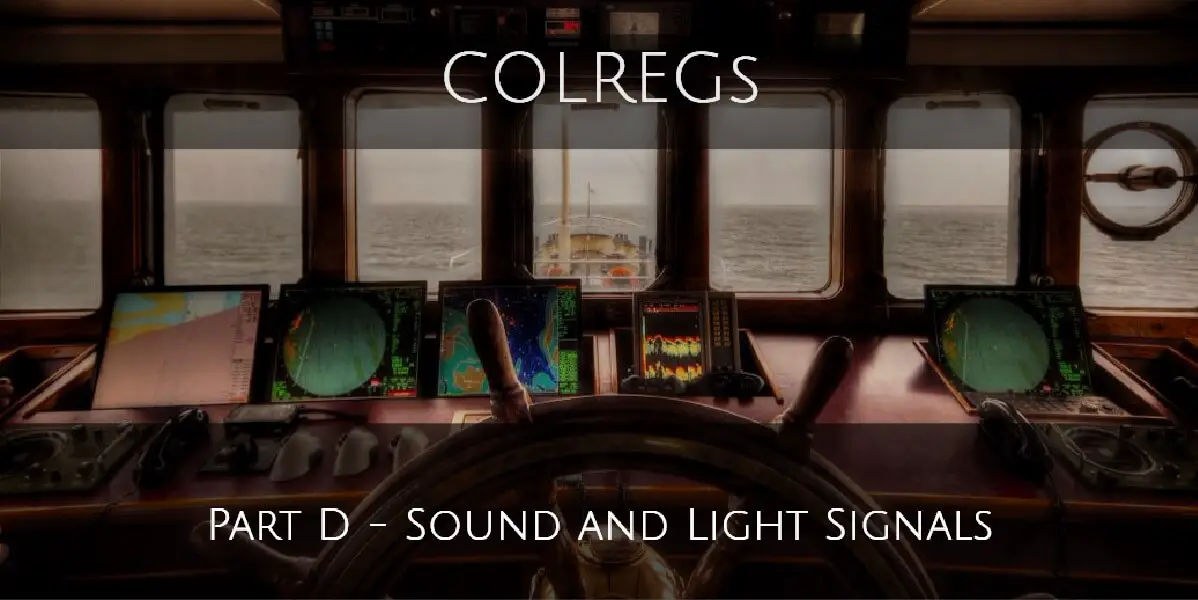Rule 35: Sound signals in restricted visibility
In or near an area of restricted visibility, whether, by day or night, the signals prescribed in this Rule shall be used as follows:
a. A power-driven vessel making way through the water shall sound at intervals of not more than 2 minutes one prolonged blast.

b. A power-driven vessel underway but stopped and making no way through the water shall sound at intervals of riot more than 2 minutes two prolonged blasts in succession with an interval of about 2 seconds between them.

c. A vessel not under command, a vessel restricted in her ability to manoeuvre, a vessel constrained by her draught, a sailing vessel, a vessel engaged in fishing and a vessel engaged in towing or pushing another vessel shall, instead of the signals prescribed in paragraphs (a) or (b) of this Rule, sound at intervals of not more than 2 minutes three blasts in succession, namely one prolonged followed by two short blasts.
d. A vessel engaged in fishing, when at anchor, and a vessel restricted in her ability to manoeuvre when carrying out her work at anchor, shall instead of the signals prescribed in paragraph (g) of this Rule sound the signal prescribed in paragraph (c) of this Rule.
e. A vessel towed or if more than one vessel is towed the last vessel of the tow if manned, shall at intervals of not more than 2 minutes sound four blasts in succession, namely one prolonged followed by three short blasts. When practicable, this signal shall be made immediately after the signal made by the towing vessel.
f. When a pushing vessel and a vessel being pushed ahead are rigidly connected in a composite unit they shall be regarded as a power-driven vessel and shall give the signals prescribed in paragraphs (a) or (b) of this Rule.
g. A vessel at anchor shall at intervals of not more than one minute ring the bell rapidly for about 5 seconds. In a vessel of 100 m or ignore in length the bell shall be sounded in the forepart of the vessel and immediately after the ringing of the bell the gong shall be sounded rapidly for about 5 seconds in the after part of the vessel. A vessel at anchor may, in addition, sound three blasts in succession, namely one short, one prolonged and one short blast, to give warning of her position and of the possibility of collision to an approaching vessel.
h. A vessel aground shall give the bell signal and if required the gong signal prescribed in paragraph (g) of this Rule and shall, in addition, give three separate and distinct strokes on the bell immediately before and after the rapid ringing of the bell. A vessel aground may, in addition, sound an appropriate whistle signal.
i. A vessel of less than 12 m in length shall not be obliged to give above-mentioned signals but, if she does not, shall make some other efficient sound signal at intervals of not more than 2 minutes.
j. A vessel of 12 m or more but less than 20 m in length shall not be obliged to give the bell signals prescribed in paragraphs (g) and (h) of this Rule. However, if she does not, she shall make some other efficient sound signal at intervals of not more than 2 minutes.
k. A pilot vessel, when engaged on pilotage duty, may in addition to the signals prescribed in paragraphs (a), (b) or (g) of this Rule sound an identify signal consisting of four short blasts.


PLS check the text at rule 35 there is a mistake on paragraph e ( photo doesnt match with the text )